During this September week in American history three famous octogenarians died who had a big impact on America:
- Daniel Boone, American explorer, died at 85 on 26 September 1820
- Theodor Seuss Geisel (better known as “Dr. Seuss”), American children’s book author, died at 87 on 24 September 1991
- Paul Newman, American actor, died at 83 on 26 September 2008
Newspapers are filled with obituaries and profiles that help us better understand the lives of our ancestors—and the famous people who lived during their times. The following newspaper articles about these three famous Americans are good examples.
Daniel Boone (1734-1820)
Daniel Boone, who died 26 September 1820, is one of the most famous figures in American history, a legendary frontiersman, hunter and explorer credited with opening up the area now known as Kentucky to white settlers. In his long, adventurous life, Boone was an officer in the American Revolutionary War; a captive of the Shawnees, who later adopted him into their tribe; and a successful politician, serving three terms in the Virginia General Assembly. When he died in Missouri in 1820, all of America mourned.
The St. Louis Enquirer published Boone’s obituary four days after he died. Today Daniel Boone is regarded as the quintessential American folk hero, and in this contemporary obituary we can see that he was held in high regard during his own time. When the Missouri General Assembly learned of Boone’s passing they sadly adjourned for the day, pledging to wear black armbands for 20 days as a sign of respect and mourning.
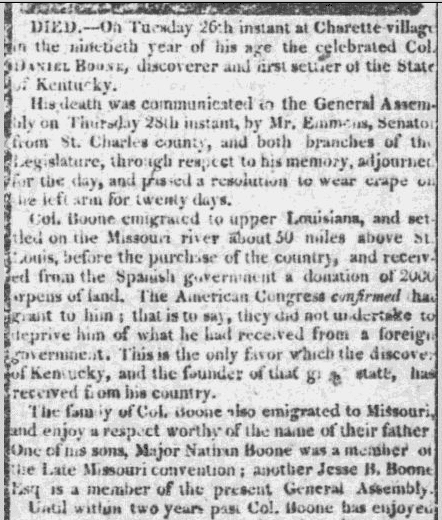
The obituary erroneously states that Boone was 90 when he died (he was 85). It reports that up until two years before his death, Boone “was capable of great bodily activity,” and notes that “Since then the approach of death was visible, and he viewed it with the indifference of a Roman philosopher.”
Here is a profile of Daniel Boone published in 1910, burnishing his legacy and legend, calling him a “courier of civilization.”
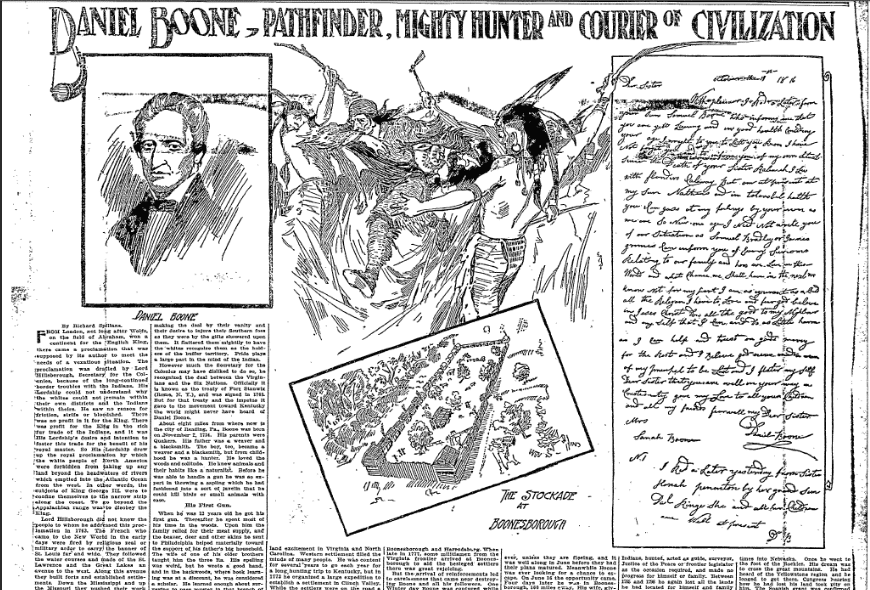
The old newspaper article states: “He found more profit in the woods than in tilling the soil, and for months at a time he was away hunting beaver, otter, bear, deer, wolves and wildcats. Garbed in hunting shirt of deerskin, with leggings and moccasins of the same material, and with powder horn, bullet pouch, scalping knife and tomahawk, the world afforded him plenty. The bare ground or the bushes furnished him a bed, and the sky was his canopy. His skill with a gun or in throwing a tomahawk was marvelous. Of Indian fighting he had enough to satisfy.”
Theodor Seuss Geisel (“Dr. Seuss”) (1904-1991)
Best known as the author and illustrator of beloved children’s books, Theodor Seuss Geisel was also a novelist, poet and cartoonist. His vivid imagination, crazy rhymes, and colorful illustrations graced 46 children’s books, creating such enduring characters as “The Cat in the Hat” and “Horton” the elephant. Generations of American children grew up learning to read from such classics as The Cat in the Hat, Green Eggs and Ham, and Horton Hears a Who!
In this obituary, published two days after Geisel’s death on 24 September 1991, we learn how the wild animals that peopled his imagination and stories came from his childhood experiences in the zoo.

Dr. Seuss’s obituary states:
“The world of Geisel’s imagination was nourished by his childhood visits to the zoo in Springfield, Mass. He was born in Springfield on March 4, 1904, the son of Theodor R. Geisel, the superintendent of parks, and Henrietta Seuss Geisel.
“Superintendent Geisel, the son of an émigré German cavalry officer who founded a brewery in Springfield, expanded the zoo and liked to show it off to his son.
“‘I used to hang around there a lot,’ Geisel recalled in an interview. ‘They’d let me in the cage with the small lions and the small tigers, and I got chewed up every once in a while.’”
Geisel did very little merchandising of his popular characters during his lifetime—but that all changed after he died, as reported in this 1997 newspaper article.
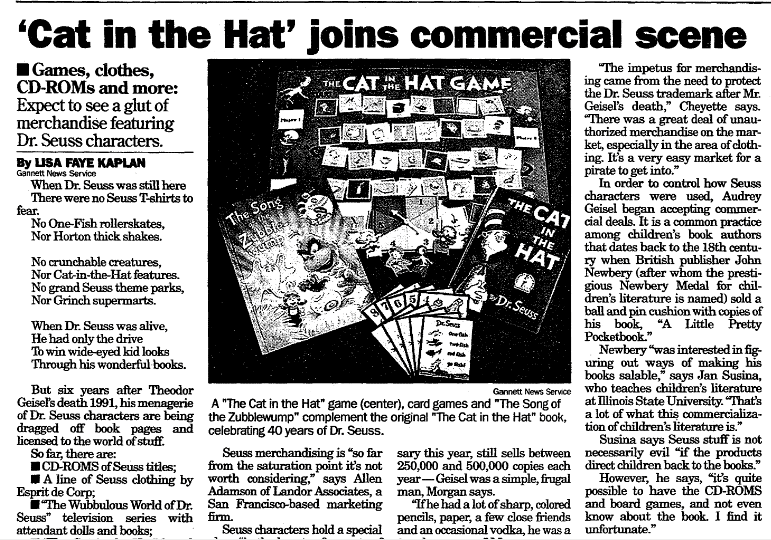
The newspaper article quotes Herbert Cheyette, Geisel’s longtime agent:
“Ted had been very reluctant to do it [merchandizing his characters],” he says. “His primary reaction was, ‘Why should I spend my time correcting the work of other people when I could do my own work creating new books?’ He said to me more than once, ‘You can do this after I’m dead.’
“In fact, Geisel’s death at 87 made merchandizing his characters a copyright necessity rather than a luxury; a case of use it or lose it, Cheyette says.”
Paul Newman (1925-2008)
Paul Newman was an Academy Award-winning American actor who appeared in more than 60 movies during his long career. Gifted, handsome, famous and wealthy, Newman shunned the Hollywood lifestyle and preferred his home life with his wife Joanne Woodward, to whom he was married 50 years—right up to his death. Newman also was a great philanthropist, co-founding a food company called “Newman’s Own” that donated more than $330 million to charity during his lifetime.
Paul Newman died on 26 September 2008; the following obituary was published the very next day.
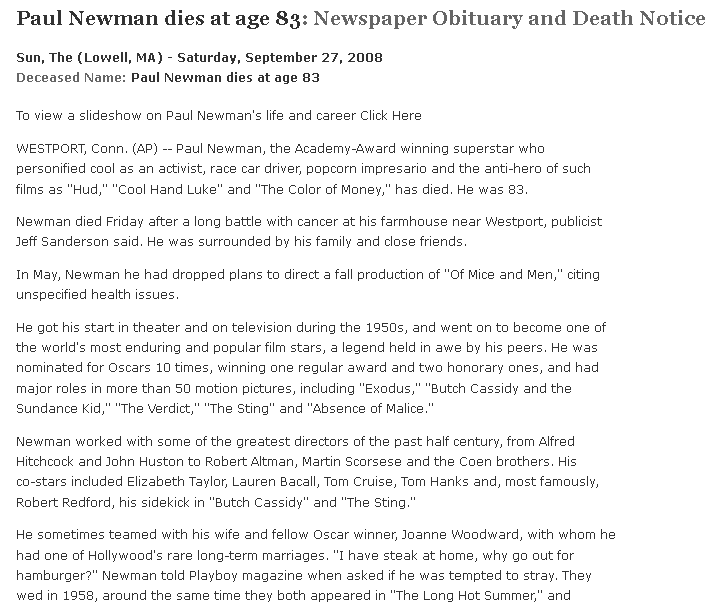
Newman’s obituary states:
“Newman, who shunned Hollywood life, was reluctant to give interviews and usually refused to sign autographs because he found the majesty of the act offensive, according to one friend.
“He also claimed that he never read reviews of his movies.
“‘If they’re good you get a fat head and if they’re bad you’re depressed for three weeks,’ he said.
“Off the screen, Newman had a taste for beer and was known for his practical jokes. He once had a Porsche installed in [Robert] Redford’s hallway—crushed and covered with ribbons.”
The following 1998 newspaper article reports on one of Newman’s charitable endeavors: he published a cookbook featuring favorite recipes from his famous actor friends.
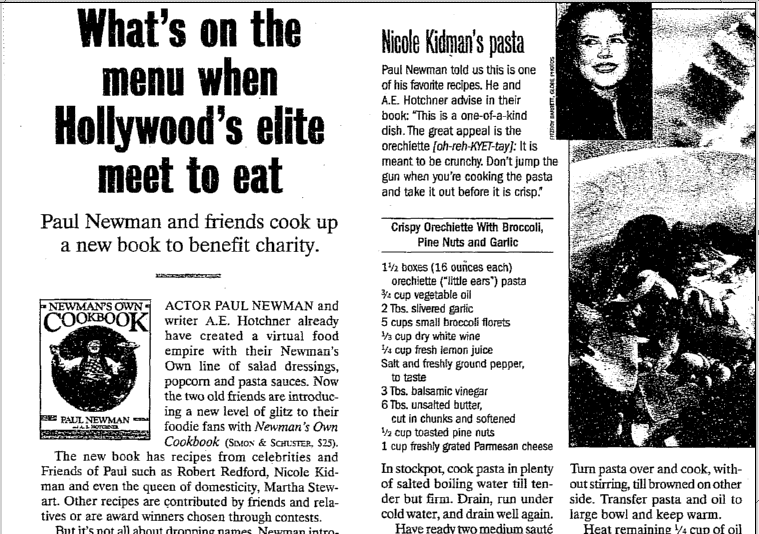
The news article reports:
“But it’s not all about dropping names. Newman introduces several recipes by recounting fond memories of meals enjoyed. He also tells about his life as the only man in his house along with his actress wife, Joanne Woodward, and five daughters, and waxes poetic about his ‘relationship’ with food.”
Obituaries provide personal details about someone’s life that we can’t find elsewhere—whether they are our ancestors or famous people we’re interested in. GenealogyBank features two collections of obituaries:
Dig into these obituary archives today and see what you can discover!
